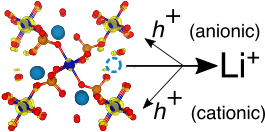Abstract
The search for an alternative high-voltage polyanionic cathode material for Li-ion batteries is vital to improve the energy densities beyond the state-of-the-art, where sulfate frameworks form an important class of high-voltage cathode materials due to the strong inductive effect of the S6+ ion. Here, we have investigated the mechanism of cationic and/or anionic redox in LixM(SO4)2 frameworks (M = Mn, Fe, Co, and Ni and 0 ≤ x ≤ 2) using density functional calculations. Specifically, we have used a combination of Hubbard U corrected strongly constrained and appropriately normed (SCAN+U) and generalized gradient approximation (GGA+U) functionals to explore the thermodynamic (polymorph stability), electrochemical (intercalation voltage), geometric (bond lengths), and electronic (band gaps, magnetic moments, charge populations, etc.) properties of the bisulfate frameworks considered. Importantly, we find that the anionic (cationic) redox process is dominant throughout delithiation in the Ni (Mn) bisulfate, as verified using our calculated projected density of states, bond lengths, and on-site magnetic moments. On the other hand, in Fe and Co bisulfates, cationic redox dominates the initial delithiation (1 ≤ x ≤ 2), while anionic redox dominates subsequent delithiation (0 ≤ x ≤ 2). In addition, evaluation of the crystal overlap Hamilton population reveals insignificant bonding between oxidized O atoms throughout the delithiation process in the Ni bisulfate, indicating robust battery performance that is resistant to irreversible oxygen evolution. Finally, we observe that both GGA+U and SCAN+U predictions are in qualitative agreement for the various properties predicted. Our work should open new avenues for exploring lattice oxygen redox in novel high voltage polyanionic cathodes, especially using the SCAN+U functional.
